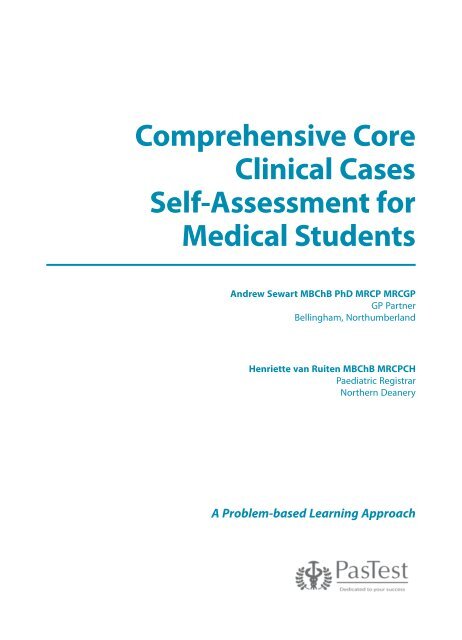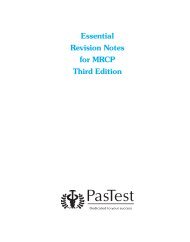Comprehensive Core Clinical Cases Self-Assessment for ... - PasTest
Comprehensive Core Clinical Cases Self-Assessment for ... - PasTest
Comprehensive Core Clinical Cases Self-Assessment for ... - PasTest
- No tags were found...
Create successful ePaper yourself
Turn your PDF publications into a flip-book with our unique Google optimized e-Paper software.
<strong>Comprehensive</strong> <strong>Core</strong><strong>Clinical</strong> <strong>Cases</strong><strong>Self</strong>-<strong>Assessment</strong> <strong>for</strong>Medical StudentsAndrew Sewart MBChB PhD MRCP MRCGPGP PartnerBellingham, NorthumberlandHenriette van Ruiten MBChB MRCPCHPaediatric RegistrarNorthern DeaneryA Problem-based Learning Approach
ContentsAcknowledgementsIntroductionAbbreviationsCASES – QUESTIONSCardiovascular 1Emergency department 17Endocrine 27Gastroenterology 37Neurology 49Obstetrics and gynaecology 59Paediatrics 71Palliative care 87Psychiatry 93Renal 97Respiratory 105Rheumatology 121Surgical 129CASES – ANSWERSCardiovascular 147Emergency department 173Endocrine 185Gastroenterology 205Neurology 229Obstetrics and gynaecology 247Paediatrics 271Palliative care 299Psychiatry 309Renal 315Respiratory 329Rheumatology 355Surgical 367Index 392viviiviiiv
CARDIOVASCULAR CASE 1Tim, a 60-year-old solicitor, visits his GP complaining of recent episodesof central chest tightness on exertion, which settles on rest. There isnothing of note in his past medical history. Tim is referred to the rapidaccesschest pain clinic, where he is diagnosed with stable angina.CARDIOVASCULARQ 1. What are the main risk factors <strong>for</strong> coronary heart disease (CHD)?5 marksQ 2. List four drugs that may be prescribed to control angina.4 marksTim is also prescribed a statin and aspirin.Q 3. What is the recommended upper limit <strong>for</strong> fasting total cholesterol (TC) andlow-density lipoprotein (LDL) in secondary prevention?2 marks3
COMPREHENSIVE CORE CLINICAL CASES SELF-ASSESSMENT FOR MEDICAL STUDENTSCARDIOVASCULARQ 4. What blood test must you request be<strong>for</strong>e prescribing a statin, and whatadvice must you give to patients on statin therapy?2 marksDespite optimised medical treatment, Tim remains symptomatic, so heundergoes coronary angiography with a view to revascularisation.Q 5. What two procedures are used <strong>for</strong> revascularisation?2 marksTotal:15 marks4
CARDIOVASCULAR CASE 2John, a 72-year-old hypertensive, visits his GP complaining of severalmonths’ history of increasing breathlessness. He is now breathless evenwhen doing simple tasks around the home, such as dressing.CARDIOVASCULARQ 1. List four non-cardiac causes of gradually progressive dyspnoea.4 marksJohn’s GP suspects heart failure and organises a number of investigations.Q 2. List four causes of heart failure.4 marksQ 3. From the history above classify John’s heart failure according to the NewYork Heart Association (NYHA) criteria.2 marks5
COMPREHENSIVE CORE CLINICAL CASES SELF-ASSESSMENT FOR MEDICAL STUDENTSCARDIOVASCULARQ 4. What hormone is significantly raised in heart failure?Q 5. Which key investigation would you request to confirm heart failure?2 marks1 markJohn is diagnosed with left ventricular heart failure.Q 6. Which two drugs are the first-line treatment <strong>for</strong> heart failure?2 marksTotal:15 marks6
SURGICAL CASE 4CARDIOVASCULARCARDIOVASCULARCASES: ANSWERS147
CARDIOVASCULAR CASE 1Tim, a 60-year-old solicitor, visits his GP complaining of recent episodesof central chest tightness on exertion, which settles on rest. There isnothing of note in his past medical history. Tim is referred to the rapidaccesschest pain clinic, where he is diagnosed with stable angina.CARDIOVASCULARQ 1. What are the main risk factors <strong>for</strong> coronary heart disease (CHD)?5 marksA 1 mark each <strong>for</strong> any of the following:AgeDiabetesSmokingHyperlipidaemia: total cholesterol > 6.5 mmol/lHypertensionSedentary lifestyleDiet high in saturated fats (and low in fruit and vegetables)Family history of CHDLEARNING POINTSÜ Stable anginal pain is: (1) constricting discom<strong>for</strong>t in the front of the chest,neck, shoulder, jaw and/or arm; (2) precipitated by physical exertion; and (3)relieved by rest or glyceryl trinitrate (GTN). Continuous or very prolonged painthat is not related to activity is unlikely to be stable angina.Ü The likelihood of suspected stable angina can be estimated from whether thepatient has typical symptoms (1–3) and the presence of risk factors such assmoking and diabetes. <strong>Clinical</strong> assessment alone may be sufficient to diagnosestable angina, although if the diagnosis is less certain it may require furtherinvestigations such as angiography, stress echocardiogram (using either exerciseor dobutamine), myocardial perfusion scans or CT calcium scoring (CT ofcoronary arteries <strong>for</strong> calcified plaques is indicative of CHD). Exercise ECG isnot recommended <strong>for</strong> diagnosing stable angina.Ü Resting ECG may be normal or may show ischaemia or previous infarction,<strong>for</strong> example abnormalities in Q waves, left bundle branch block (LBBB),ST-segment or T-wave abnormalities (eg flattening or inversion).149
COMPREHENSIVE CORE CLINICAL CASES SELF-ASSESSMENT FOR MEDICAL STUDENTSCARDIOVASCULARQ 2. List four drugs that may be prescribed to control angina.A 1 mark each <strong>for</strong> any of the following:Beta-blockerCalcium-channel blocker: use a dihydropyridine calcium-channel blocker (egamlodipine)Long-acting nitrateIvabradine: slows down heart rate by inhibiting the sinus nodeNicorandil: vasodilatorRanolazine4 marksLEARNING POINTSÜ Optimal drug treatment consists of one or two anti-anginal drugs; first-lineare -blockers and/or calcium-channel blockers. Use other anti-anginal drugsif symptoms are not satisfactorily controlled or if -blockers/calcium-channelblockers are not tolerated or are contraindicated.Ü Also give a short-acting nitrate <strong>for</strong> preventing and treating episodes of angina.Advise patients on common side-effects (headache, flushing, light-headed);use it during episodes of angina and be<strong>for</strong>e exercise or exertion; if treatingan episode of angina, repeat dose after five minutes if pain persists, and callambulance if pain is still present five minutes after second dose.Tim is also prescribed a statin and aspirin.Q 3. What is the recommended upper limit <strong>for</strong> fasting total cholesterol (TC) andlow-density lipoprotein (LDL) in secondary prevention?2 marksA 1 mark each <strong>for</strong> the following:TC < 4 mmol/lLDL < 2 mmol/lLEARNING POINTÜ Patients with existing CHD should ideally have a fasting TC of < 4 mmol/l (or a25% reduction from baseline, whichever is the greater) and LDL of < 2 mmol/l(or a 30% reduction, whichever is the greater).150
CARDIOVASCULAR CASE 1Q 4. What blood test must you request be<strong>for</strong>e prescribing a statin, and whatadvice must you give to patients on statin therapy?2 marksA 1 mark each <strong>for</strong> the following:Liver function tests (LFTs)LEARNING POINTÜ Statins are potentially hepatotoxic (as evidenced by an increase inaminotransferases) and are contraindicated in active liver disease. LFTs shouldbe checked at baseline, at three months and at one year. Discontinue if ALT/AST rise to three times the upper limit (normal range is 3–35 IU/l). Patients should report any unexplained muscle pains, tenderness or weakness.CARDIOVASCULARLEARNING POINTÜ Although rare, statins may give rise to myositis (diagnosed by raised creatinekinase (CK)), causing muscle pain, weakness and tenderness. In severe casesthis can lead to rhabdomyolysis and acute renal failure. Risk is increased inpresence of co-morbidities such as renal impairment or if statins are used incombination with other drugs (eg macrolide antibiotics, fibrates).Despite optimised medical treatment, Tim remains symptomatic, so heundergoes coronary angiography with a view to revascularisation.Q 5. What two procedures are used <strong>for</strong> revascularisation?2 marksA 1 mark each <strong>for</strong> the following:Percutaneous coronary intervention (PCI): angioplasty (balloon dilatation) andstenting. It improves symptoms but not prognosis.Coronary artery bypass graft (CABG) (eg using saphenous veins or internalthoracic arteries). It improves prognosis in a subset of patients with CHD(> 65 years old, multi-vessel disease, diabetic).LEARNING POINTÜ Stents are either bare-metal or drug-eluting. The latter have a reduced risk ofrestenosis, although an increased risk of stent thrombosis, so patients are puton both aspirin and clopidogrel (<strong>for</strong> one year).Total:15 marks151
CARDIOVASCULARCARDIOVASCULAR CASE 2John, a 72-year-old hypertensive, visits his GP complaining of severalmonths’ history of increasing breathlessness. He is now breathless evenwhen doing simple tasks around the home, such as dressing.Q 1. List four non-cardiac causes of gradually progressive dyspnoea.4 marksA 1 mark each <strong>for</strong> any of the following:Chronic obstructive pulmonary disease (COPD)Fibrotic lung diseaseLung cancerPleural effusionMultiple pulmonary emboliAnaemiaLEARNING POINTÜ Initial investigations in progressive dyspnoea may include: electrocardiogram(ECG), chest X-ray, spirometry and blood tests, including full blood count, toexclude anaemia.John’s GP suspects heart failure and organises a number of investigations.Q 2. List four causes of heart failure.4 marksA 1 mark each <strong>for</strong> any of the causes listed below:Heart failure is caused by structural or functional abnormalities of the heart:Ischaemic heart diseaseHypertensionCardiomyopathies, eg dilated cardiomyopathyValvular heart disease, eg mitral regurgitation (volume overload), aortic stenosis(obstruction to outflow)High output, eg anaemia, hyperthyroidismArrhythmia, eg atrial fibrillation152
CARDIOVASCULAR CASE 2Cor pulmonale: right heart failure secondary to pulmonary disease, eg COPDLEARNING POINTSÜ Heart failure itself can be classified in a number of ways, including:Left versus right heart failure; when occurring together (mostcommonly) it is termed congestive heart failure. This is useful <strong>for</strong>understanding clinical symptoms and signs. Symptoms of left heartfailure include dyspnoea, orthopnoea, paroxysmal nocturnal dyspnoea(PND) and cardiac wheeze. Symptoms of right-sided failure includeperipheral oedema, anorexia and nausea (caused by bowel oedema),and abdominal distension due to ascites.Systolic dysfunction versus diastolic dysfunction – or left ventricularsystolic dysfunction (LVSD) versus heart failure with preserved ejectionfraction (HFPEF) – owing to insufficient contraction or relaxation,respectively, of the ventricle, and both causing a reduced stroke volume.The reduced stroke volume in HFPEF is due to a stiff ventricle (egsecondary to hypertension).CARDIOVASCULARQ 3. From the history above classify John’s heart failure according to the NewYork Heart Classification (NYHA) criteria.2 marksA Grade III heart failure, ie breathlessness on minimal exertion.LEARNING POINTNYHA heart failure classificationGradeIIIIIIIVExtent of breathlessnessNo undue breathlessnessBreathlessness on moderate exertionBreathlessness on minimal exertionBreathlessness at restQ 4. What hormone is significantly raised in heart failure?2 marksA B-type (or brain) natriuretic peptide (BNP).153
COMPREHENSIVE CORE CLINICAL CASES SELF-ASSESSMENT FOR MEDICAL STUDENTSCARDIOVASCULARLEARNING POINTÜ BNP is secreted by the ventricular myocardium in response to distension andacts to reduce circulating volume by inhibiting renin, antidiuretic hormone(ADH) and aldosterone secretion (similar actions to atrial natriuretic peptide(ANP)). BNP levels are raised in heart failure and are used as a screeningtest <strong>for</strong> patients with suspected untreated heart failure. BNP levels < 100 pg/ml make heart failure unlikely, while high levels (> 400 pg/ml) carry a poorprognosis.Q 5. Which key investigation would you request to confirm heart failure?1 markA Echocardiogram: this is the key investigation in heart failure. It will confirm thediagnosis and its severity and may indicate the cause.LEARNING POINTÜ Parameters assessed by echocardiography include left ventricular systolic anddiastolic function, regional/localised hypokinesis (as a result of underlyingcoronary heart disease) and valvular function.John is diagnosed with left ventricular heart failure.Q 6. Which two drugs are the first-line treatment <strong>for</strong> heart failure?2 marksA 1 mark each <strong>for</strong> any of the following:Angiotensin-converting-enzyme inhibitors (ACEi); angiotensin II receptorblockers (ARBs) are an alternative first-line treatment, but may also be used incombination with ACEi as second-line treatmentBeta-blockers (eg bisoprolol, carvedilol)LEARNING POINTSÜ Drug treatment of heart failure is shown in the figure opposite. * ACE inhibitors,-blockers and aldosterone antagonists improve prognosis. Diuretics anddigoxin improve symptoms but do not reduce mortality.Ü Cardiac resynchronisation therapy (CRT) involves implantation of a154
CARDIOVASCULAR CASE 2bi-ventricular pacemaker. By ensuring the heart contracts in synchrony, cardiacfunction is maximised, thus improving both symptoms and prognosis. CRT isindicated in patients with NYHA grade III–IV symptoms on optimal medicalmanagement, an ejection fraction 35% and a QRS duration > 150 ms(indicating cardiac dys-synchrony).CARDIOVASCULARDrug treatment <strong>for</strong> heart failure due to left ventricular systolicdysfunction*The treatment flow diagram is <strong>for</strong> patients with heart failure due to left ventricular systolicdysfunction (LVSD). Management of patients with heart failure with preserved ejection fraction(HFPEF) is primarily aimed at optimising treatment of underlying conditions such ashypertension, diabetes and coronary heart disease.Total:15 marks155
















